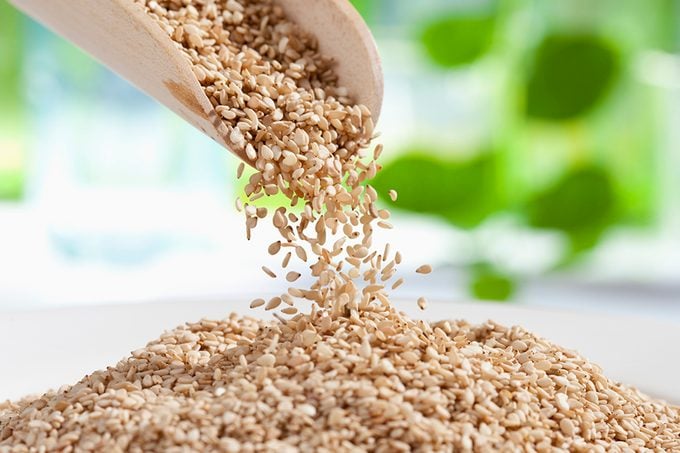What Is Tahini?
Updated: Feb. 13, 2024

Practically all of your favorite dishes can be made better with this popular Middle Eastern ingredient.
A staple in North African, Asian and Middle Eastern countries for millennia, tahini is a beloved sesame-based condiment that first hit the U.S. scene in the 1940s. However, it wasn’t until even more recent years (and the burgeoning hummus obsession!) that it became such a hot mainstream commodity. Now let’s dig in—literally!
Check out these convenient condiment recipes.
What Is Tahini?
Tahini requires no more than two simple ingredients: sesame seeds and a mild oil. You can use any type of sesame seed, including natural, hulled, raw, sprouted, toasted or even black, but typically, tahini is made with hulled seeds. And as for the oil, think olive oil, grapeseed oil or even a splash of sesame oil. See our full explainer on oils here.
Tahini is surprisingly similar to other nut and seed butters—both in texture and in preparation. But it does stray from its counterparts in taste. At its best, tahini is creamy, savory and nutty. Some varieties are astringent, but if it’s overly acidic, then it’s time to toss it. In order to stay fresh, the spread must be stored in the fridge after opening.
Aside from complementing practically everything it touches and tasting downright delicious, tahini touts a number of health benefits. The creamy spread is high in protein, fiber, monounsaturated fats, and vitamins B1 and B2. What’s not to love?
How Do You Use Tahini?
You’ve seen (and loved) it in hummus, but the versatile ingredient enhances nearly any recipe—yes, that includes baked goods. It’s not very often you come across a condiment that seamlessly stirs into sweet and savory recipes. Score!
We love it tossed with Asian noodles, swirled into salad dressing, drizzled over roasted cauliflower or other veggies, rolled into pinwheels or wraps, and, of course, blended into hummus. It even works slathered on toast with honey, so buh-bye peanut butter.
To add tahini to baked goods, incorporate it how you would any other nut or seed butter. Cakes, cookies and brownies can all benefit from a dollop of the dreamy ingredient.
Where Is Tahini in the Grocery Store?
Thankfully the in-demand spread is popular to the point of being available at tons of stores. Buy it at Target, Walmart, Meijer, Whole Foods and even Amazon from their health-foods or ethnic sections.
How to Make Tahini
If you’re feeling extra ambitious, whip up a homemade batch of tahini! Here’s how.
Ingredients
- 1 cup sesame seeds
- Neutral oil of your choice
Editor’s Tip: To find inexpensive sesame seeds in bulk, go to your local Middle Eastern or Asian market.
Step 1: Toast the seeds
If you want to use toasted sesame seeds for a nuttier flavor, toast in a dry skillet (like this Taste of Home one) over medium heat. Stir occasionally, until lightly colored and fragrant, 4-5 minutes.
Step 2: Process into a paste
Place the seeds in a food processor with an s-blade (or go old school with a mortar and pestle!) and process for 2-3 minutes. The result will be a crumbly paste.
Step 3: Add oil
Add 2 Tbsp. oil of your choosing to the food processor and process for 1-2 minutes longer, scraping the sides as necessary. The once-crumbly paste will have become smoother but remain thick. Continue adding oil, 1 Tbsp. at a time, to reach desired consistency.
Step 4: Store and enjoy
Transfer tahini to an airtight container and store in the refrigerator for 1-2 months…if it lasts that long!






















